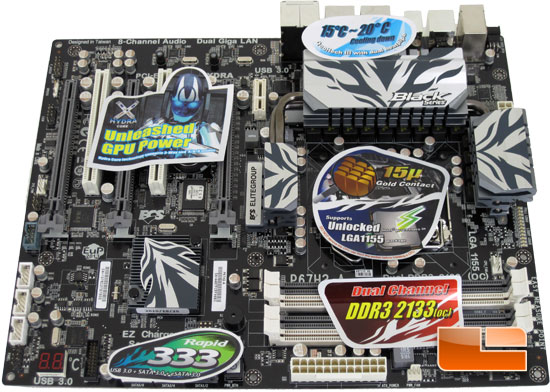ECS P67H2-A Black Extreme Motherboard Performance Review
Final Thoughts and Conclusion

There are several features of the ECS P67H2-A that I like; unfortunately, there are also those that I am not impressed with. The Layout of the ECS P67H2-A was well thought out. All of the SATA ports come out parallel to the PCB. This allows us to run the lengthy graphics cards like the NVIDIA GeForce GTX 580’s without interference from the SATA Cables. The on board buttons for power and reset are placed above the graphics cards which allows easy access if you are running multiple graphics cards in CrossfireX.
Let’s start out with gaming performance. If you are planning on running a single graphics card on the ECS P67H2-A Black Extreme, the good news is that single card performance was on par with the other Intel P67 boards that we have tested. When we added a second XFX Radeon HD 6970 in AMD CrossfireX we saw a boost in performance that is on par with the other boards that we have looked at. NVIDIA SLI performance, or Hydra performance since the ECS P67H2-A Black Extreme isn’t licensed for NVIDIA SLI, was severely lacking. In only one of the three games that we tested the ECS P67H2-A Black Extreme with our pair of Galaxy GeForce GTX 460’s were we able to see a solid boost in performance. Aliens Vs. Predator saw a gain that was comparable to the boards that are licensed for SLI; this gave me hope for the Lucid Hydra technology. After that we went on to Metro 2033 and saw a boost that was only ~4%. Then we moved on to S.T.A.L.K.E.R.: Call of Pripyat and the gains were even lower, less than a 1% gain. When it comes down to it, the Lucid Hydra technology isn’t worth it to me. We saw very little gains in our gaming performance, and in all honesty I would have been happier to see NVIDIA SLI licensing instead.
Unlike the boards that we have tested previously, there is no auto overclock feature on the ECS P67H2-A Black Extreme. Is that good or bad? Well, it depends on your perspective. The ECS P67H2-A Black Extreme is aimed towards the enthusiast crowd, many of whom are already overclockers and prefer to push their systems manually. There are those that like to take the easy route and use a feature like MSI’s OC Genie and be done with it. There is absolutely nothing wrong with that route, all I am getting at is that for a ~$250 motherboard we should have the option.
Another of the features that I found lacking for an “Extreme” board is the BIOS. The BIOS for the ECS P67H2-A Black Extreme seemed very rough when compared to our past boards. I’ll be honest, I’m not just talking about the ASUS P8P67 boards that we looked at and the MSI P67A-GD65 that all feature uEFI BIOS. I am referring to the majority of boards that have come across my bench in the last year. The layout of the BIOS was tricky, and some of the items within the BIOS were difficult to find. When overclocking with the ECS P67H2-A Black Extreme I expected to find the Bclk adjustment on the same page as the multiplier, while in fact it was several sub-pages away. I’m not necessarily knocking the ECS P67H2-A Black Extreme for the lack of uEFI BIOS, though for a $250 “Extreme” motherboard one might expect it. There are certain features one has come to expect inside today’s BIOS. The simple ability to flash the BIOS from within was lacking for the ECS P67H2-A Black Extreme. I had to flash the BIOS through Windows which is one of my least favorite tasks to do. It wouldn’t have been the first motherboard to become a paper weight because the flash got corrupted in Windows. We’d like to see any and all enthusiast motherboards be updated with a built-in USB Flash drive utility!
When it comes down to it, of all the features that didn’t impress me about the ECS P67H2-A Black Extreme, the Lucid Hydra core technology is what left me feeling disappointed. Sure the BIOS is on the rough side for my taste, but I was able to get everything done that I needed to with them. The overclocking wasn’t the greatest; hopefully we will see a new BIOS revision coming out that will give us the option to enable the internal PLL Voltage. That will increase the overclocking ability of the ECS P67H2-A Black Extreme. If I could make one change to the ECS P67H2-A Black Extreme, I would add NVIDIA SLI licensing. Fortunately for us, ECS has a pretty solid line of boards that will be hitting the market, most likely after the Cougar Point error is corrected. Included in the up and coming line is the P67H2-A2. The A2 revision of the board does feature SLI capabilities and will retail for only $189.99. The ECS P67H2-A2 features only two PCIe X16 slots versus the three on the ECS P67H2-A. There are a few other differences, though; the NVIDIA SLI licensing and number of PCIe X16 slots are the key differences. ECS also has a micro ATX Intel H67 board coming out, the H67H2-M, which will retail for $149.99. ECS is also bringing a mini-ITX Intel H67 board to the party, the H67H2-I is $94.99 and features a single PCIe X16 and two DIMM slots. It is also packed with features like Bluetooth and HDMI that will make it ideal for an HTPC.
ECS Sandy Bridge Motherboard Lineup:
- P67H2-A $249.99
- P67H2-A2 $189.99
- H67H2-M $149.99
- H67H2-I $94.99
Legit Bottom Line: The performance of the ECS P67H2-A was average at best. When it comes down to it, though, the performance and lack of true SLI support doesn’t warrant the premium price for the ECS P67H2-A Black Extreme.

Comments are closed.